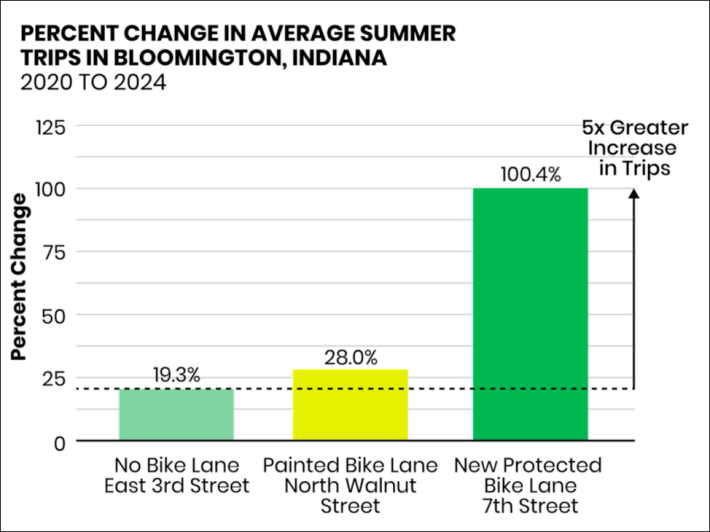It may sound obvious, but if cities build more — and safe — bike lanes, cyclists will use them more ... and be safer.
That's the basic finding of a new study released today by the League of American Bicyclists and mobility giant Lime, which studied ridership data between 2019 and 2024 in Washington, D.C., and Bloomington, Indiana to see if mobility users prefer certain bike infrastructure and whether it made them safer.
Yes and yes.
Ridership numbers
In D.C., a major metro with a population just shy of 700,000 residents, new and especially protected bike lanes led to a huge boost in riding compared to existing infrastructure or streets with no bike lanes, according to Lime.
The company said trips on its bikes increased by 128 percent between 2020 and 2023 — but trips on new bike infrastructure jumped 726 percent while trips on streets with no bike lanes "only" increased by 358 percent over the same period.
And bike riders used streets with bike lanes about 40 percent of the time, the report states, even though only 10 percent of D.C. streets have bike infrastructure. This equals an increase of about 20 additional Lime trips per day, compared to streets with no bike lanes.

In areas where bike lanes were installed in 2020, trip volume surged by 780 percent compared to trips than those on similar streets with no bike lanes:

In Bloomington, a city of nearly 86,000 people, the study focused on streets in the downtown area and near Indiana University campus. Trips on recently constructed protected bike lanes along Seventh Street, for example, experienced a 100-percent increase in trips compared to a 28-percent percent increase on a similar street with existing bike lanes, and a 19-percent increase on a similar street with no bike infrastructure.

Just as in D.C., trips in Bloomington were more concentrated around streets that had bike infrastructure. Mobility users chose streets with bike infrastructure nearly 60 percent of the time, even though only about one-quarter of the streets have bike lanes.
“It’s just like that classic [saying], if you build it, they will come,” said Amelia Neptune, an author of the report, and director of LAB’s Bicycle Friendly America program.
Safety first...
It's obvious that building bike lanes makes cycling safer.
According to Lime, virtually all user trips in D.C. are incident-free — about 99.99 percent. Despite those already low numbers, between 2021 and 2024, crashes decreased by 39 percent, the report states — which coincides with a 38-percent increase in bike lanes in the District.
Bloomington’s user reported safety incidents were almost identical to D.C.’s, with about 99.98 percent of Lime trips being incident-free. And crashes dropped dramatically from about two in every 10,000 trips in 2023 to roughly seven in every hundred-thousand trips in 2024 — a decrease of 65 percent. City officials and researchers are still looking at why this happened, but are pleased with the result.
“It's a good change,” said Hank Duncan, bike and pedestrian coordinator with the City of Bloomington, “but how do we make sure that this change stays consistent?”
Looking ahead
Bloomington and D.C. have been investing in mobility and safety improvements over the years, with the capital district increasing its mobility program from 3,600 vehicles in 2019 to almost 19,000 in 2024, a 400-percent increase. At the same time, the city installed nearly 41 miles of new bike lanes during. Bloomington, meanwhile, added about 9.3 miles of bike facilities.
And this work is critical; both D.C. and Bloomington have Vision Zero goals and are facing an uphill fight to reach them. In D.C. there were 40 traffic fatalities in 2024 so far, compared to 37 this time last year. Two cyclists died in 2024 compared to one last year. (DDOT declined to comment.)
In Bloomington, one scooter rider was killed between 2018 and 2022 (and no cyclists were killed), according to city documents. This, along with the U.S. mandate to reduce vehicle greenhouse gas emissions, makes what cities and advocates can glean from this report even more important.
This recent report has limits. It only draws from one shared mobility company (D.C. currently works with four, and Bloomington has two, including Lime). Researchers are hoping the report can help other cities see how an increase in infrastructure and parking creates a positive kind of induced demand for electric vehicles rather than cars.
For Duncan the report will allow his city to make smart choices when it comes to infrastructure and parking implementation.
“This partnership has given us the ability to expand this program – and that is a goal of ours – and not just choose more locations, but better locations,” Duncan said. "We need more protected, low-stress infrastructure."
Correction: An earlier version of this story wrongly reported slightly higher crash incident numbers in D.C. This version is correct.






